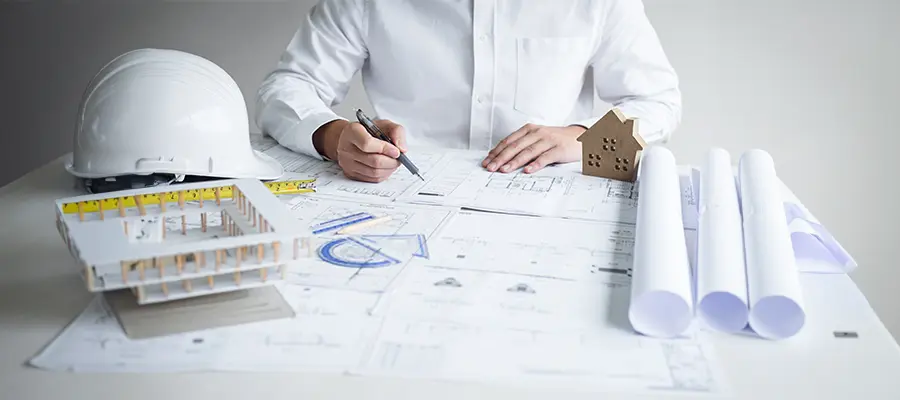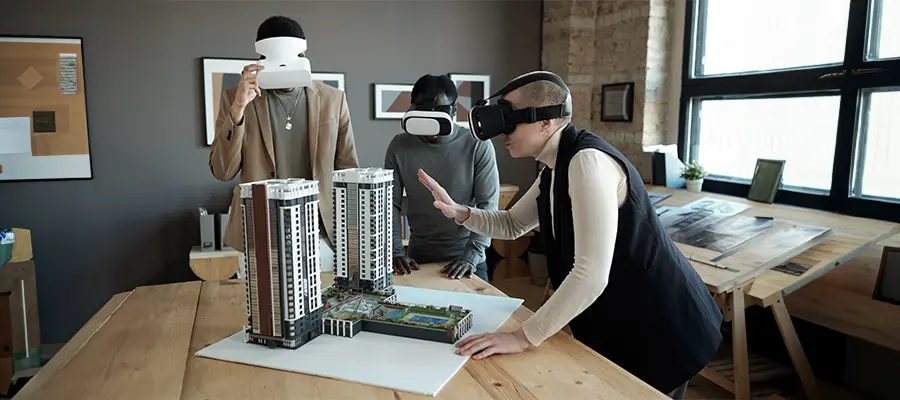Virtual reality (VR) and augmented reality (AR) are two genuinely game-changing technologies in the always-changing field of design and construction. These immersive technologies are changing the game in the entertainment design and construction sectors. In this blog, Brick & Bolt will discuss the application of VR and AR in the planning, design, and construction stages and the advantages these technologies offer for planning visualisation and client interaction. It will also provide instances of how these technologies are transforming the sector.
VR and AR in Design and Construction
1. Design Phase:
Immersive Design Exploration:
Using virtual reality (VR), architects and designers may experience their concepts at a human scale by stepping inside an immersive, three-dimensional world. This degree of immersion offers priceless insights into spatial relationships, helping designers hone their ideas and spot possible problems before work starts.
Interactive 3D Modeling:
AR enhances the design process by superimposing digital data on the real environment. By visualising 3D models of structures on construction sites, architects and engineers may utilise augmented reality (AR) to give their ideas a real-world context and facilitate accurate positioning and alignment.
2. Construction Phase:
Guided Construction with AR:
Construction workers can examine real-time information superimposed on their field of vision with AR-enabled devices like smart glasses. This can involve visualising construction designs, emphasising structural components, and even providing step-by-step instructions to cut down on errors and boost overall construction process efficiency.
Virtual Walkthroughs with VR:
Virtual reality technology is utilised to generate captivating virtual tours of building sites. Stakeholders can virtually inspect the location, evaluate its development, and spot any obstacles. This facilitates decision-making and improves teamwork, lowering the possibility of costly changes being made later.
Benefits in Visualization, Planning, and Client Engagement
1. Visualisation:
Enhanced Spatial Understanding:
Virtual reality offers a degree of spatial comprehension unmatched by conventional two-dimensional depictions. With the ability to walk through places digitally, customers and designers can intuitively experience scale and proportions, enabling them to make better design decisions.
Real-time Design Adjustments:
Designs can be changed in real-time with both VR and AR. Architects can make quick adjustments, and clients can see the results immediately, promoting a collaborative and iterative design process.
2. Planning:

Efficient Project Planning:
AR makes project planning more efficient by superimposing digital models onto real-world locations. This facilitates accurate site planning, assisting building crews in placing components like beams, columns, and utilities as efficiently as possible.
Construction Sequencing with VR:
Project teams can detect possible bottlenecks and optimise building timetables using VR to mimic construction sequences. Proactive planning helps provide a more seamless project completion process.
3. Client Engagement:
Immersive Client Presentations:
Virtual reality offers architects an effective tool for client presentations. Before construction, clients can virtually explore suggested concepts to get a genuine sense of the completed product. This improves client happiness and makes it easier to make more informed decisions.
Interactive Design Reviews with AR:
AR is used in design evaluations so clients can explore virtual spaces superimposed with digital models. This collaborative process encourages participation and guarantees that clients fully get the design purpose.
Examples of VR and AR Changing the Industry

1. The Mars Habitat Project by NASA:
Creating housing with special spatial restrictions for upcoming Mars missions is a challenge.
Solution: NASA created immersive environments using virtual reality, giving designers personal experience with the difficulties of Martian dwellings.
As a result, NASA was able to maximise efficiency in spatial layouts and make well-informed design selections.
2. Microsoft’s HoloLens in Construction:
Improving cooperation and communication on building sites is a challenge.
Solution: Microsoft’s HoloLens augmented reality device enables real-time construction team cooperation by superimposing digital data on the real world.
As a result, there is better communication, fewer mistakes, and more efficiency in the building operations.
3. The Sydney Metro West Project:
Planning and coordinating a complicated underground train project efficiently is a challenge.
Solution: Using virtual reality (VR) to generate a digital twin of the underground infrastructure allowed planners to optimise project timeframes and simulate construction sequences.
The result is better project execution, lower risks, and better project planning.
Virtual and augmented reality are already essential tools in the construction and design arsenal, moving beyond the domain of sci-fi conceptions. Planning, visualisation, and client interaction all yield clear benefits, and the industry is undergoing a radical change towards more immersive, cooperative, and effective procedures.
The possibilities are endless as long as we keep utilising these technologies. VR and AR are shaping the future of the design and construction industries, from creating colonies on Mars to streamlining procedures on Earth. The trip is just starting, and as these technologies advance, so will our methods for envisioning, organising, and constructing the buildings that define our surroundings. Greetings from the future of design and building, where limitless possibilities await you and reality is transformed.
To experience a hassle-free dream home construction in Bangalore, book a free consultation with Brick & Bolt and enjoy the construction experience with us.

